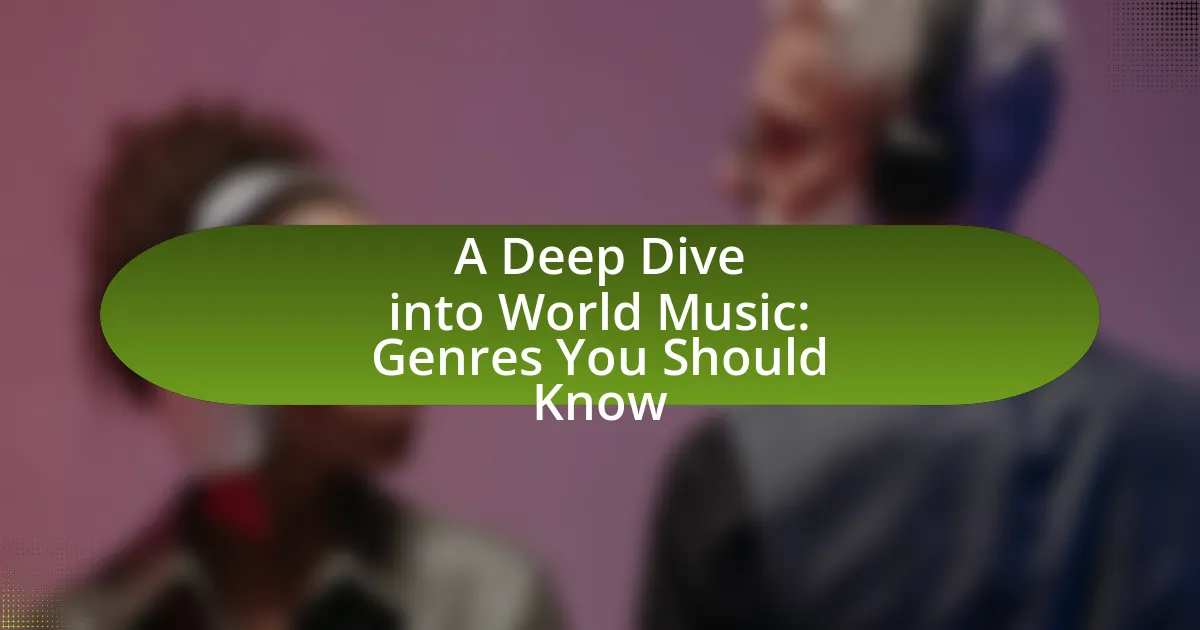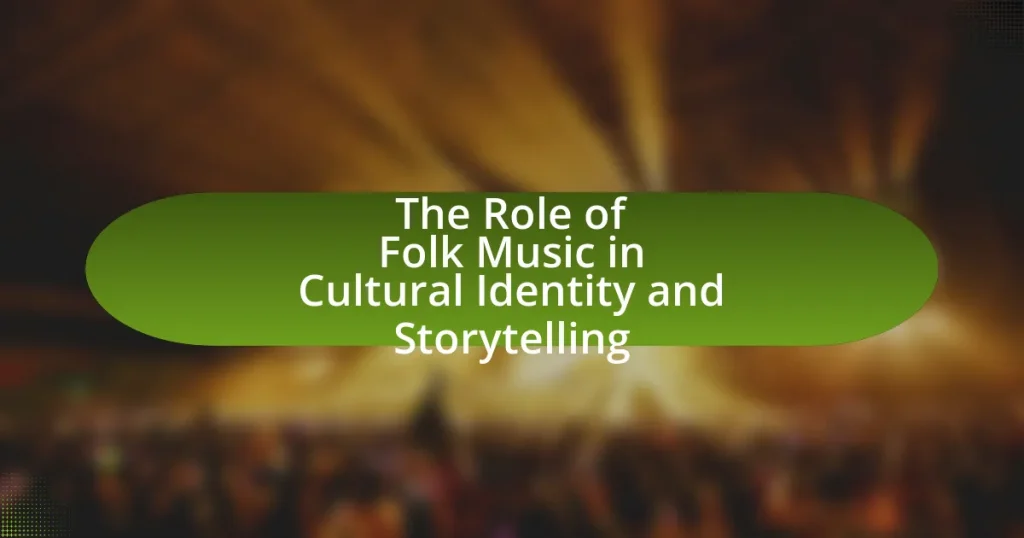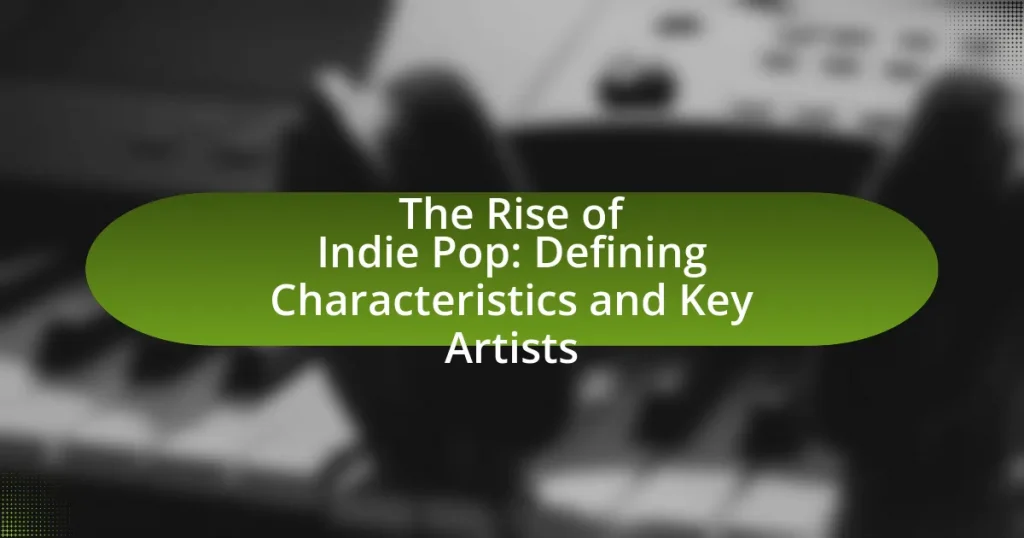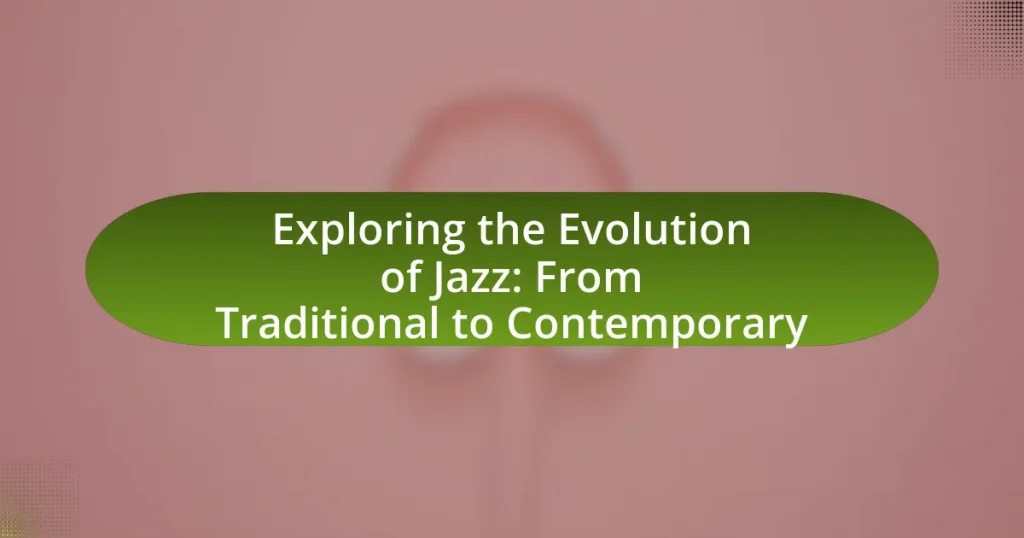World music is a diverse genre that encompasses various musical styles from around the globe, particularly those outside the mainstream Western tradition. This article explores the definition of world music in contemporary culture, its key characteristics, and its significance in promoting cultural exchange and social movements. It highlights major genres such as Reggae, Afrobeat, Flamenco, and Bhangra, and discusses how regional influences shape these styles. Additionally, the article provides insights on how to appreciate world music, discover new artists, and engage with this rich musical landscape through live performances and educational resources.
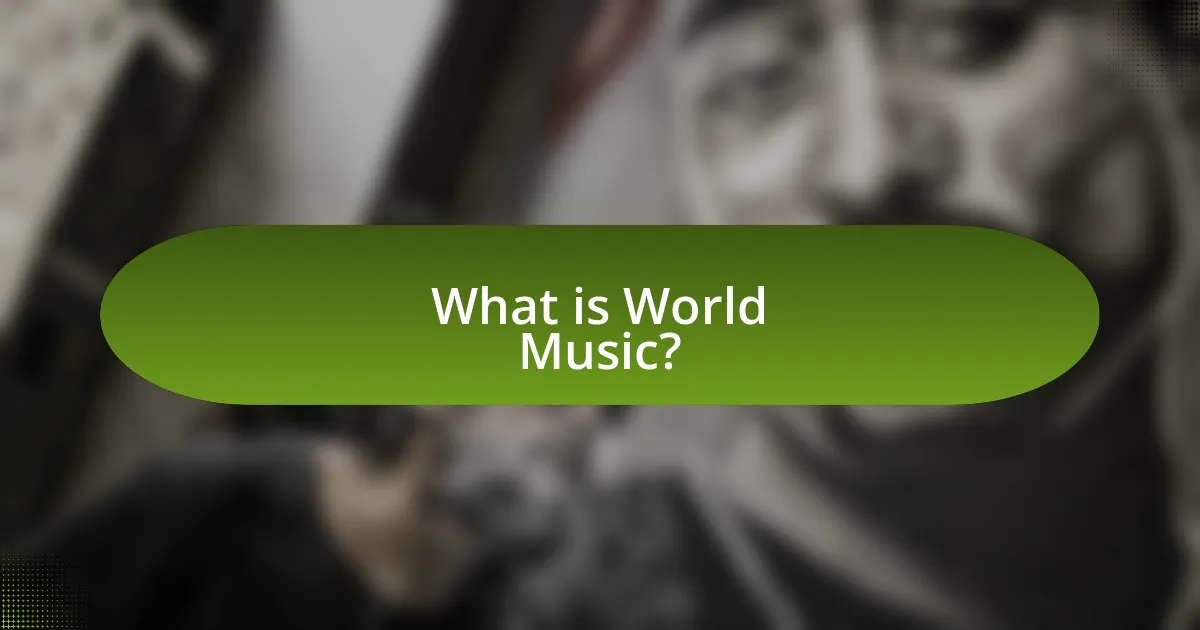
What is World Music?
World music refers to a broad category of music that encompasses diverse musical styles from around the globe, particularly those that are not part of the mainstream Western music tradition. This genre includes traditional music, folk music, and contemporary music that reflects the cultural heritage of various regions, often incorporating indigenous instruments and rhythms. The term gained prominence in the late 20th century as a way to categorize and promote music from non-Western cultures, facilitating cross-cultural exchange and appreciation. World music often highlights the unique characteristics of different cultures, making it a vital part of global musical diversity.
How is World Music defined in contemporary culture?
World Music in contemporary culture is defined as a genre that encompasses a diverse range of musical styles originating from various global traditions, often characterized by the blending of indigenous sounds with contemporary influences. This genre has gained prominence due to globalization and the accessibility of music through digital platforms, allowing for cross-cultural collaborations and the fusion of different musical elements. For instance, artists like Yo-Yo Ma and Anoushka Shankar exemplify this blending by incorporating traditional instruments and styles into modern compositions, thereby expanding the definition and reach of World Music.
What are the key characteristics that distinguish World Music?
World Music is distinguished by its diverse cultural origins, unique instrumentation, and distinct rhythmic and melodic structures. This genre encompasses traditional music from various cultures around the globe, often incorporating indigenous instruments such as the sitar, djembe, or didgeridoo, which contribute to its unique sound. Additionally, World Music frequently features complex rhythms and scales that differ from Western music, reflecting the cultural heritage and practices of the communities from which it originates. For example, African music often employs polyrhythms, while Indian classical music utilizes raga scales, showcasing the rich variety within the genre.
How does World Music differ from traditional music genres?
World Music differs from traditional music genres primarily in its inclusive nature, encompassing a wide variety of musical styles from different cultures around the globe. While traditional music genres are often rooted in specific cultural or regional practices, World Music blends these diverse influences, creating a fusion that transcends geographical boundaries. For instance, World Music may incorporate elements from African rhythms, Asian melodies, and Latin beats, resulting in innovative sounds that reflect global interconnectedness. This genre often emphasizes collaboration among artists from various backgrounds, as seen in projects like “Playing for Change,” which unites musicians worldwide to create a shared musical experience.
Why is World Music important in a global context?
World Music is important in a global context because it fosters cultural exchange and understanding among diverse populations. This genre encompasses a wide range of musical traditions from various cultures, allowing listeners to experience and appreciate different cultural expressions. For instance, the rise of World Music festivals, such as the WOMAD festival, highlights the global interest in diverse musical forms, attracting audiences from multiple backgrounds and promoting cross-cultural dialogue. Additionally, studies show that exposure to World Music can enhance empathy and social cohesion, as it encourages individuals to engage with and respect cultural differences.
What role does World Music play in cultural exchange?
World Music plays a crucial role in cultural exchange by facilitating the sharing and blending of diverse musical traditions across global communities. This genre often incorporates elements from various cultures, allowing artists to collaborate and create new sounds that reflect a fusion of influences. For instance, the rise of genres like Afrobeat and Reggaeton showcases how traditional African and Caribbean rhythms have influenced contemporary music, promoting cross-cultural understanding and appreciation. Additionally, events such as global music festivals and online platforms enable artists from different backgrounds to reach wider audiences, further enhancing cultural dialogue and exchange.
How does World Music contribute to social and political movements?
World Music contributes to social and political movements by serving as a powerful medium for expression and mobilization. It often reflects the struggles, aspirations, and cultural identities of marginalized communities, thereby raising awareness and fostering solidarity. For instance, the anti-apartheid movement in South Africa was significantly influenced by artists like Miriam Makeba and Hugh Masekela, whose music highlighted the injustices faced by black South Africans and galvanized international support. Additionally, genres such as reggae, particularly through the works of Bob Marley, have been instrumental in promoting messages of resistance and social justice, influencing movements globally. These examples illustrate how World Music not only articulates social and political issues but also inspires collective action and change.
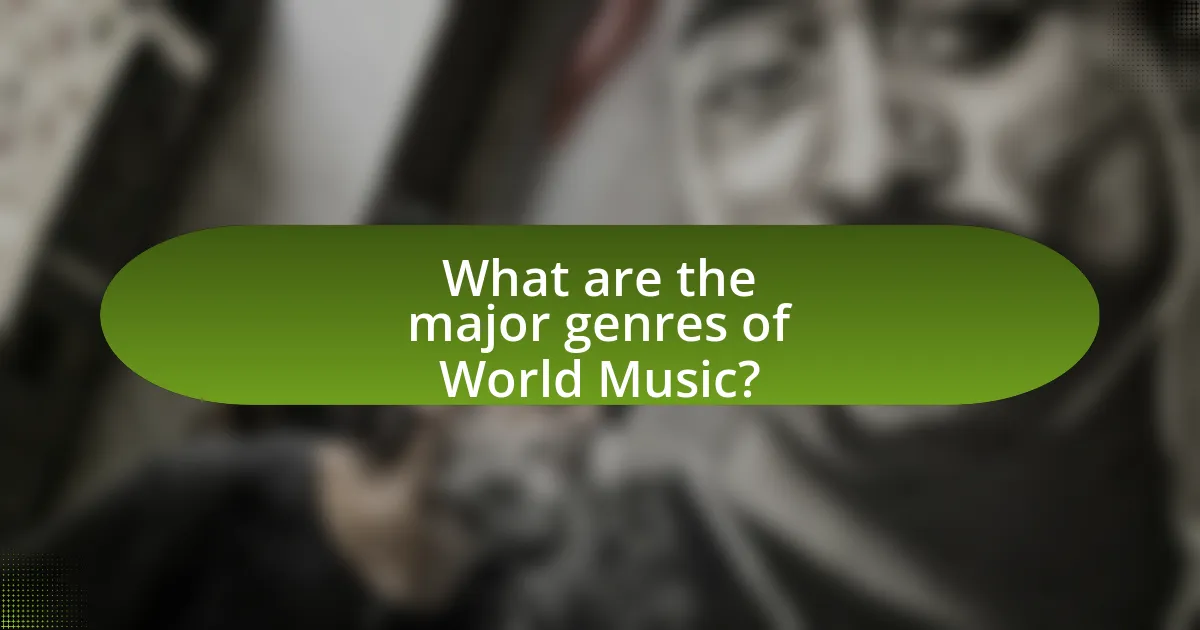
What are the major genres of World Music?
The major genres of World Music include traditional folk, classical, popular, and contemporary styles from various cultures. Traditional folk music often reflects the cultural heritage and history of a community, while classical music encompasses the formal musical traditions of specific regions, such as Indian classical or Western classical. Popular music incorporates modern influences and is widely accessible, often blending elements from different cultures. Contemporary styles, such as worldbeat, fuse various musical traditions with modern genres, showcasing the global interconnectedness of music. These genres highlight the diversity and richness of musical expressions across the globe.
How do regional influences shape World Music genres?
Regional influences shape World Music genres by integrating local cultural elements, instruments, and musical traditions into broader musical forms. For instance, the incorporation of African rhythms and call-and-response patterns significantly influenced the development of genres like jazz and blues in the United States. Additionally, the use of traditional instruments, such as the sitar in Indian classical music or the djembe in West African music, adds unique textures and sounds that define specific genres. This blending of regional characteristics not only enriches the music but also reflects the historical and social contexts of the regions, such as migration patterns and colonial histories, which further diversify the global music landscape.
What are the defining features of African music genres?
African music genres are characterized by their rhythmic complexity, use of traditional instruments, and strong cultural ties. The rhythmic complexity often includes polyrhythms, where multiple contrasting rhythms are played simultaneously, creating a rich auditory experience. Traditional instruments such as the djembe, kora, and mbira are commonly used, each contributing unique sounds that reflect regional cultures. Additionally, African music is deeply intertwined with social and spiritual practices, often serving as a medium for storytelling, rituals, and community gatherings, which reinforces its cultural significance.
How do Asian music genres reflect cultural traditions?
Asian music genres reflect cultural traditions through their distinct musical styles, instruments, and lyrical themes that embody the values, beliefs, and histories of various communities. For instance, traditional Chinese music often utilizes instruments like the guzheng and erhu, which are integral to cultural ceremonies and storytelling, highlighting the importance of harmony and nature in Chinese philosophy. Similarly, Indian classical music, characterized by ragas and talas, serves not only as entertainment but also as a spiritual practice, deeply rooted in Hindu traditions and rituals. These genres preserve and transmit cultural narratives, showcasing the diversity and richness of Asian heritage.
What are some popular World Music genres to explore?
Popular World Music genres to explore include Reggae, Afrobeat, Flamenco, Bhangra, and Fado. Reggae originated in Jamaica in the late 1960s and is characterized by its rhythmic style and socially conscious lyrics. Afrobeat, developed by Nigerian musician Fela Kuti in the 1970s, combines traditional African music with jazz and funk elements. Flamenco, a passionate music and dance form from Spain, showcases intricate guitar work and vocal techniques. Bhangra, originating from the Punjab region of India and Pakistan, blends traditional folk music with modern influences. Fado, a genre from Portugal, is known for its expressive and melancholic themes, often accompanied by guitar. Each genre reflects unique cultural backgrounds and musical traditions, making them significant in the world music landscape.
What is the significance of Reggae in World Music?
Reggae is significant in world music as it serves as a powerful vehicle for social and political messages, originating from Jamaica in the late 1960s. This genre has influenced global music trends, promoting themes of resistance, unity, and cultural identity. Notably, artists like Bob Marley have brought reggae to international prominence, with songs such as “One Love” and “Get Up, Stand Up” addressing issues like inequality and human rights. The incorporation of reggae rhythms and styles into various music genres, including hip-hop and rock, further underscores its impact on the global music landscape.
How does Flamenco represent Spanish cultural heritage?
Flamenco represents Spanish cultural heritage through its unique blend of music, dance, and expressive storytelling that reflects the historical influences of various cultures in Spain, particularly the Romani, Moorish, and Andalusian traditions. This art form embodies the emotional depth and cultural identity of the Spanish people, showcasing themes of love, struggle, and passion. The incorporation of traditional instruments like the guitar and castanets, along with distinctive vocal styles, further solidifies Flamenco’s role as a vital expression of regional identity. Flamenco has been recognized by UNESCO as an Intangible Cultural Heritage of Humanity since 2010, highlighting its significance in preserving and promoting Spanish cultural heritage globally.
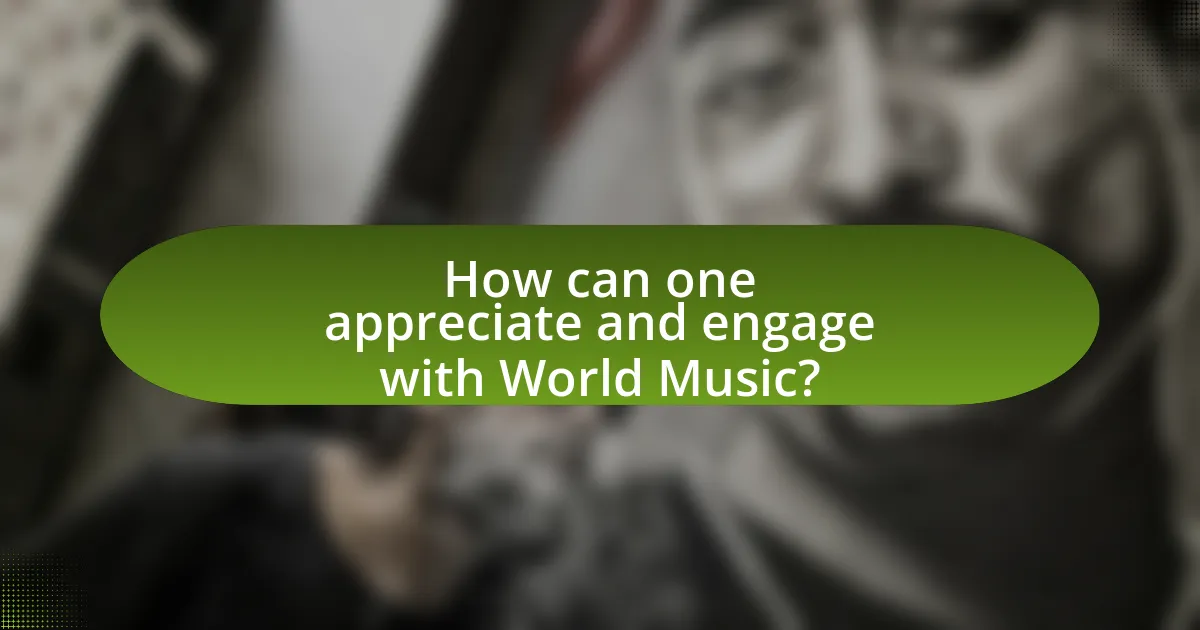
How can one appreciate and engage with World Music?
One can appreciate and engage with World Music by actively listening to diverse genres, attending live performances, and exploring cultural contexts. Engaging with World Music involves immersing oneself in the sounds and rhythms from various cultures, which can be achieved by utilizing streaming platforms that offer curated playlists from different regions. Attending concerts or festivals featuring international artists provides firsthand experience of the music’s cultural significance. Additionally, understanding the historical and social backgrounds of the music enhances appreciation; for instance, recognizing how African rhythms influenced jazz or how traditional Indian music incorporates spiritual elements can deepen one’s connection to the genre.
What are effective ways to discover new World Music artists?
Effective ways to discover new World Music artists include exploring streaming platforms, attending world music festivals, and engaging with social media communities dedicated to global music. Streaming platforms like Spotify and Apple Music often curate playlists featuring emerging artists from various cultures, making it easier to find new sounds. World music festivals, such as WOMAD and GlobalFest, showcase diverse artists and provide opportunities for live performances, which can lead to discovering new talent. Additionally, social media platforms like Instagram and TikTok allow users to follow artists and music influencers who share recommendations and promote lesser-known musicians, enhancing the discovery process.
How can attending live performances enhance the World Music experience?
Attending live performances enhances the World Music experience by providing an immersive environment that fosters a deeper connection to the music and its cultural context. Live performances allow audiences to engage with artists directly, experiencing the energy and emotion that cannot be replicated through recordings. This interaction often includes visual elements such as traditional costumes and dance, which enrich the understanding of the music’s cultural significance. Additionally, studies show that live music can evoke stronger emotional responses, with research indicating that shared experiences in a communal setting can enhance enjoyment and appreciation of diverse musical genres.
What role do music festivals play in promoting World Music?
Music festivals play a crucial role in promoting World Music by providing a platform for diverse cultural expressions and facilitating cross-cultural exchanges. These events showcase artists from various countries, allowing attendees to experience a wide range of musical styles and traditions that they may not encounter otherwise. For instance, festivals like WOMAD (World of Music, Arts and Dance) have featured artists from over 90 countries, highlighting the global nature of music and fostering appreciation for different cultures. Additionally, music festivals often include workshops, discussions, and performances that educate audiences about the historical and social contexts of the music, further enhancing the understanding and appreciation of World Music.
What resources are available for learning about World Music?
Resources available for learning about World Music include online platforms, academic courses, books, and documentaries. Online platforms such as Coursera and edX offer courses on World Music that cover various genres and cultural contexts. Academic institutions often provide specialized programs in ethnomusicology, which is the study of music in its cultural context. Books like “World Music: A Global Journey” by Philip V. Bohlman and “The Study of Ethnomusicology: Thirty-One Issues and Concepts” by Bruno Nettl serve as comprehensive texts for understanding the subject. Documentaries, such as “The Music of Strangers,” provide visual and auditory insights into different musical traditions around the world. These resources collectively enhance knowledge and appreciation of World Music across diverse cultures.
Which online platforms offer World Music education and exploration?
Online platforms that offer World Music education and exploration include Coursera, Udemy, and MasterClass. Coursera provides courses from universities and institutions that cover various aspects of World Music, including cultural contexts and musical styles. Udemy features a range of courses focused on specific genres and instruments from around the world, allowing learners to explore diverse musical traditions. MasterClass offers classes taught by renowned musicians who share insights into their cultural influences and musical techniques, enhancing the understanding of World Music.
How can books and documentaries deepen understanding of World Music?
Books and documentaries can deepen understanding of World Music by providing in-depth cultural context, historical background, and diverse perspectives on various musical genres. For instance, books like “World Music: A Global Journey” by Philip V. Bohlman offer comprehensive insights into the social and cultural significance of music across different regions, while documentaries such as “The Music of Strangers” showcase the personal stories of musicians from various backgrounds, illustrating how music serves as a universal language. These resources enhance appreciation and knowledge by connecting music to its cultural roots and the experiences of its creators, thereby fostering a more nuanced understanding of World Music.
What tips can help you integrate World Music into your life?
To integrate World Music into your life, actively explore diverse genres by listening to artists from various cultures. Engaging with platforms like Spotify or YouTube allows you to discover playlists dedicated to World Music, showcasing genres such as Afrobeat, Reggae, and Flamenco. Participating in local cultural events or festivals can also enhance your experience, as these gatherings often feature live performances and workshops that immerse you in the music and traditions of different communities. Additionally, learning to play an instrument associated with a specific genre, such as the djembe for West African music, can deepen your appreciation and understanding. Research indicates that exposure to diverse musical styles can enhance cognitive flexibility and cultural awareness, making these practices beneficial for personal growth.
